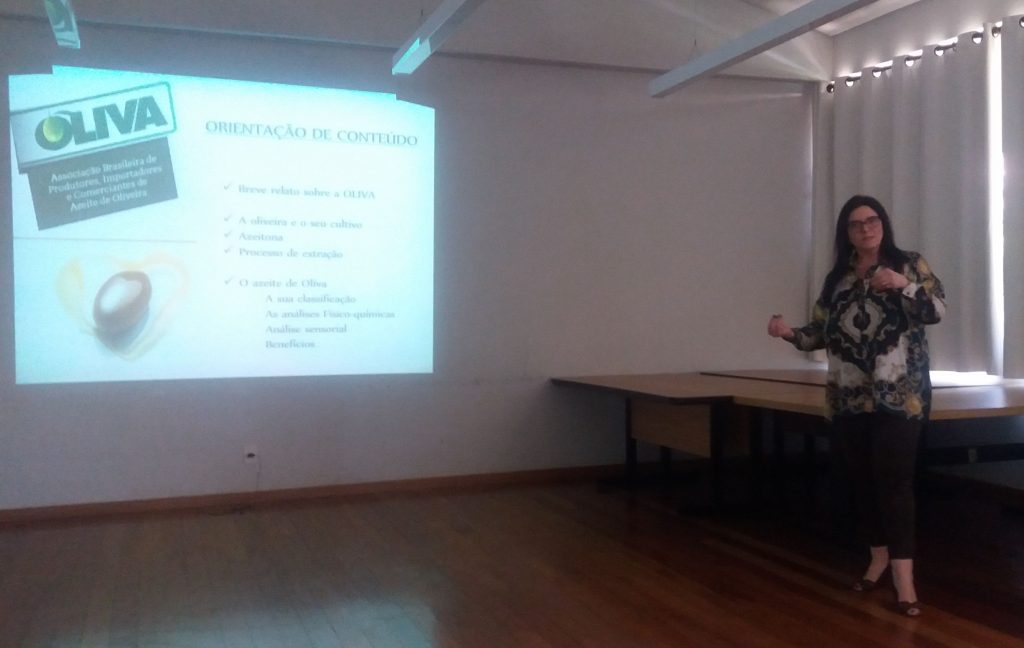São Paulo – A wider range of foreign olive oil brands have arrived in Brazil, very interested in the domestic market. The statement is from the president of the Brazilian Association of Olive Oil Producers, Importers and Traders (OLIVA), Rita Bassi (picture above), who spoke this Thursday (22) at the workshop “Knowing the Olive Oil”, at university Universidade Aberta do Meio Ambient and da Cultura da Paz (UMAPaz), in São Paulo.
According to Bassi, Brazilians began, some time ago, to fully appreciate the product, and the size of the domestic market has been drawing the attention of many olive oil producing countries. “Look at the size of Brazil, look at the size of our population, so it is evident that there is an interest, the Arabs are interested, products from these countries are arriving,” said the president, recalling that Brazil is also a growing olive oil producing market.
Bassi mentioned among those interested in exporting their olive oil to Brazil the Moroccans, Egyptians and Tunisians. Data compiled by the Arab Brazilian Chamber of Commerce show that, from January to September of this year, Brazil imported USD 4 million worth of olive oil from the Arab world, almost all of it from Tunisia. Last year, olive oil imports totaled USD 2.1 million, which means that, until September, this year’s imports have doubled. Again, Tunisia accounted for over 90% of the imports.
“Tunisia is opening itself up to the world, seeking market not only here,” said Bassi to ANBA. She mentioned that OLIVA has been working together with the Arab Chamber to promote the olive oil of Arab countries in Brazil, and that the association is also part of the Brazil-Tunisia Business Council. The group includes representatives from the corporate sector of both countries and promotes bilateral trade.
Currently, the world’s largest producer and exporter of olive oil is Spain, in a tight competition with Italy. Both countries supply to Brazil. Data compiled by the Arab Chamber shows that Portugal is the top supplier of olive oil to Brazil, followed by Spain, Argentina, Chile and Italy. The Arab countries, as a bloc, come up in the sixth position. Among the Arabs, Tunisia leads and is followed by Lebanon as Brazil’s top Arab suppliers.
OLIVA’s president offered some thoughts on the olive oil market in the workshop but took most of the time to explain the production process and what to consider when evaluating the quality of an olive oil. The event was organized with the support of São Paulo’s Environment Municipal Secretariat (SVMA, in the Portuguese acronym) to celebrate the World Olive Day on November 24. OLIVA is a member of the International Olive Council (IOC).
OLIVA works to ensure the quality of the olive oil sold in the Brazilian market, identifying the brands with improper products. Bassi said that the virgin olive oil is a “olive oil juice” and should not have any chemical substance, other food or oil added. She described the production process, from the harvest of the olives to the extraction of olive oil.
According to Bassi, today there are olive oil farms that adopt the traditional production process, usually the older ones, with manual harvest and irrigation only by rain. In these farms, there are between 100 to 200 trees per hectare. There are also farms using the intensive production process, with 200 to 400 trees per hectare and partial irrigation, and the ones using the super intensive production process, with 1,000 to 2,000 trees per hectare. The latter are the ones with the large outputs.
Olive oil is produced in a place called Lagar, in which the olives go through a cleaning and washing process. Later, they go to the grind, where they are mashed with the seeds. The next phase is the malaxation, when they are again grinded, coming out as a paste that is taken to centrifugation. In this process, the olive oil is separated from the pomace. Then, the paste go through another centrifugation process to eliminate the impurities that might have remained.
Bassi says that a large volume of olives is needed to produce a couple of liters of olive oil. To produce between six to 10 liters of olive oil, for instance, 40 to 60 kg of olives are needed, according to OLIVA’s president. An olive is made up of only 18% to 32% of olive oil. Brazil produces olive oil, in states such as Minas Gerais and Santa Catarina, but the production is still underdeveloped.
Translated by Sérgio Kakitani




